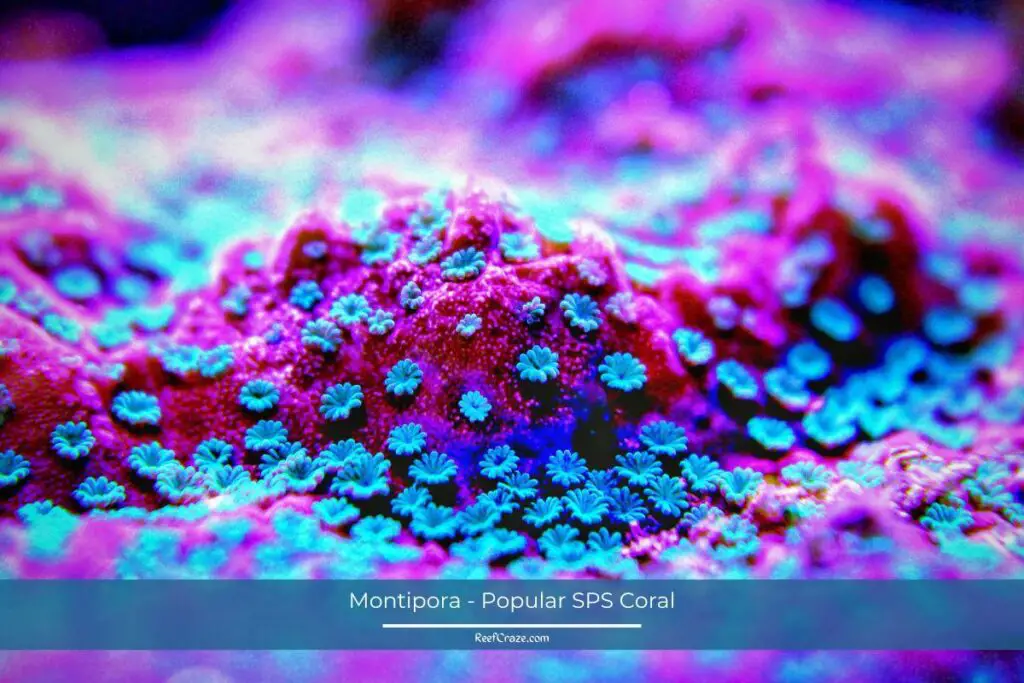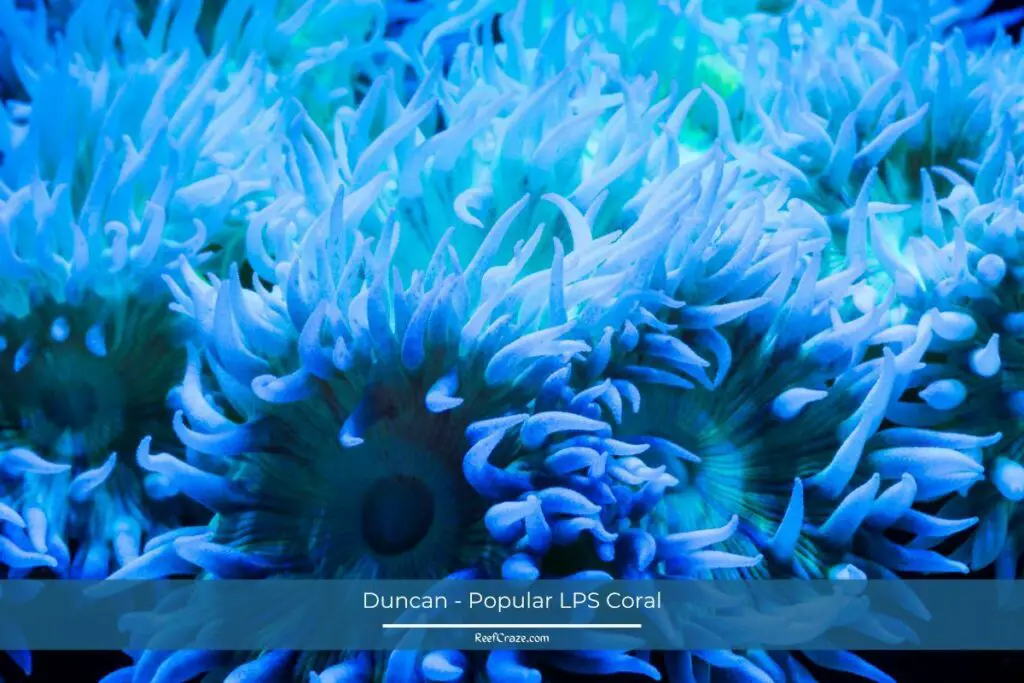There are countless categories and subcategories of marine life in every saltwater system. Among them, coral resides in the most shallow and tropical waters with direct access to sunlight. Unlike others, they cannot withstand sheer darkness and freezing temperatures.
Corals are neither plants nor rocks. Belonging to marine species, they are animals without a vertebral column. So it makes them invertebrates. They come from a vast taxonomic group containing more than 11,000 species of anemone, jellyfish, coral, gorgonians, etc.
If we single out coral from that group and try to categorize it, we will find Small Polyp Stony (SPS), Large Polyp Stony (LPS), Soft, Gorgonians, Mushrooms, and Zoanthids.
Let’s get acquainted with each coral type and its well-known members.

What Are The Types Of Corals?
At first thought, soft and hard corals often become the 2 categories of corals based on their skeleton type – solid or delicate. But we can break down that categorization further and split them into 6 types: LPS, SPS, Gorgonians, Mushrooms, Zoanthids, and Softies.
They have similar characteristics, as they are different types of the same animal. Again, each has its distinct nature due to its specie type. Some are too demanding and unsuitable for beginners. Others are highly compatible with flexible needs.
You should know what you will deal with before bringing a coral into your reef tank. It will prepare you in advance to handle everything better. How about starting that process with their introduction?
1. Small Polyp Stony (SPS)
Per the implication of their name, the Small Polyp Stony Corals (SPS) belong to the Hard Coral group. Their hard skeletons comprise calcium carbonate and tiny delicate polyps poking out occasionally along their solid physical structure.
SPS corals can be broadly categorized into several groups based on their growth form and skeletal structure. These categories include branching, digitate, encrusting, foliose, massive, plating, and tabular.

Branching Corals:
Branching corals are characterized by their branching growth form and often have small, needle-like polyps. They can grow in a variety of shapes and sizes, from delicate, fine-branched corals to more robust and sturdy colonies. Examples of branching corals include Acropora, Stylophora, and Pocillopora species.
Digitate Corals:
Digitate corals have a more finger-like growth form and long, tapering polyps. They can form dense, bushy colonies or more open, spaced-out formations. Examples of digitate corals include Acropora and Montipora species.
Encrusting Corals:
Encrusting corals grow horizontally along a surface and have small, flat polyps. They can form a thin layer over rock or other surfaces, or can grow more robustly and form thicker, more three-dimensional colonies. Examples of encrusting corals include Montipora and Porites species.
Foliose Corals:
Foliose corals have a leaf-like appearance and often have long, flowing polyps. They can form delicate, lace-like colonies or more robust, solid formations. Examples of foliose corals include Acropora and Montipora species.
Massive Corals:
Massive corals grow in a more dome-like shape and have intricate skeletal structures. They can form large, solid colonies or smaller, more irregular shapes. Examples of massive corals include Porites and Goniopora species.
Plating Corals:
Plating corals grow in thin, flat plates and often have small, round polyps. They can form delicate, lace-like formations or more robust, solid plates. Examples of plating corals include Montipora and Acropora species.
Tabular Corals:
Tabular corals grow in a table-like shape and have large, flat polyps. They can form large, solid colonies or smaller, more irregular shapes. Examples of tabular corals include Acropora and Montipora species.
It’s important to note that while these categories can help to distinguish between different types of SPS corals, there can be significant variation within each group, and some SPS corals may exhibit characteristics of multiple growth forms.
Whichever type you choose, all SPS corals share similar needs like high water flow, consistent water quality, and high lighting arrangements.
They have a slow growth rate because they require time to grow hard skeletons. But Seriatopora and Montipora grow relatively faster than their groupmates.
Although some SPS corals are exceptionally high maintenance and require expertise and experience, some are beginner-friendly. Acropora, Montipora, Stylophora, Pocilopora, and Seriatopora are the most popular corals for reef tanks because of their easygoingness. A bunch of them, all colorful and vibrant, indicate a healthy and happy reef system.
2. Large Polyp Stony (LPS)
LPS corals consist of a variety of species with exotic appearances. Their name is due to their calcium carbonate, stony skeletons with meaty and large polyps. They are exceedingly famous among reef enthusiasts because of their catchy colors that look amazing when they flow in the current.
They are less high-maintenance than SPS corals. You can have them in moderate water flow and lighting. Their flexibility allows you to keep them in a broader array of conditions with fewer and more affordable devices.

Some LPS corals have aggressive characteristics and long tentacles, i.e., torch corals of Euphyllia glabrescens. But others are harmless and friendly, particularly the Blastomussa species.
They fall under the order of the Scleractinia with their fellow hard corals. The discrepancy is mainly due to their meaty polyps covering almost all of their skeletons, making them hardly visible.
LPS corals can be broadly categorized into several groups based on their growth form and skeletal structure. These categories include branching, encrusting, foliose, massive, and solitary.
Branching Corals:
Branching LPS corals have a branching growth form, with multiple branches that extend out from a central stalk. They can have small or large polyps, and often have bright colors and intricate patterns. Examples of branching LPS corals include Euphyllia and Torch corals.
Encrusting Corals:
Encrusting LPS corals grow horizontally along a surface and have small, flat polyps. They can form a thin layer over rock or other surfaces, or can grow more robustly and form thicker, more three-dimensional colonies. Examples of encrusting LPS corals include Favia and Leptastrea species.
Foliose Corals:
Foliose LPS corals have a leaf-like appearance and often have long, flowing polyps. They can form delicate, lace-like colonies or more robust, solid formations. Examples of foliose LPS corals include Goniopora and Blastomussa species.
Massive Corals:
Massive LPS corals grow in a more dome-like shape and have intricate skeletal structures. They can form large, solid colonies or smaller, more irregular shapes. Examples of massive LPS corals include Brain and Bubble corals.
Solitary Corals:
Solitary LPS corals are characterized by their individual, freestanding colonies. They can come in a variety of shapes and sizes, from small and round to large and elongated. Examples of solitary LPS corals include Elegance and Wellsophyllia species.
Similar to SPS corals, these categories can help to distinguish between different types of LPS corals, but there can be significant variation within each group, and some LPS corals may exhibit characteristics of multiple growth forms. Additionally, it’s important to source LPS corals from reputable suppliers who practice sustainable and ethical collection methods.
3. Soft Corals
Although people often group Softies and LPS, they are entirely distinct. They do not even belong to the same taxonomic subclasses. True Softies are from the Octocorallia subcategory, and LPS come from the Hexacorallia community.
They are called Softies or Soft Corals because they have no protective skeletons. Instead, their little bony structure is covered with soft tissues named sclerites that do not have load-bearing properties. Looking closely, you can locate the tissue appearing like small fingernail clippings attached to the fragile body.
Softies are the favorite corals of aquarium hobbyists because most of their kinds suit reefers of all expertise levels. Most effortless to maintain, they can get along with low to medium water flows without heavy lighting. Plus, they are accepting of beginner’s mistakes.
Additionally, they populate and grow faster. So you will find them more available and less costly than others, especially cabbage, toadstools, Kenya tree, etc.
Related Article: Difference Between Soft, LPS and SPS Corals
4. Gorgonians
Gorgonians are unique in that their skeletons are not stony or soft but leathery. They have plenty of starving polyps, looking to extend further to catch plankton-sized prey and thrive in medium to slightly high water flow.
They are of 2 types: photosynthetic and non-photosynthetic. When looking for them, determine which one you want because the photosynthetic ones require sufficient lighting to collect their energy. That is a strict requirement, but taking care of them is more manageable than the non-photosynthetic ones.
Also, some species are not suitable to keep in a home aquarium. So it is better to go for photosynthetic Gorgonians, namely Green Lace, Purple Brush, Golden Plume, Orange Spiny, and Purple Knobby.
5. Zoanthids
Many aquarists adore Zoanthid corals because of their mesmerizing colors. Each psychedelic color has a particular and often funny name, like Eagle Eyes, Whammin Watermelon, Bam Bam, etc.
Aquarium owners love them so much that they often reserve a large area of their tanks for Zoanthids to flaunt their prepossessing polyps.
Zoanthids are photosynthesis but do not ask for heavy lighting like other corals. They are okay with both high and low lighting arrangements. Experts recommend that you place them around the lower-middle area of your tank. It will allow them to grow upwards if they need more light.
The water flow should be low-medium or medium-high for them. Too high flow will make it difficult for their polyps to extend. You know you have a happy band of Zoas when their polyps are spontaneously open without appearing too upright or stretched.
You should be cautious before bringing them home because a specie called Palythoa uses a chemical called Palythoa to protect itself. It is harmful to us. People with their families have been known to fall sick because of handling them poorly. It is wise to look for other gentle and harmless Zoanthids, even if you have experience.
6. Mushrooms
The last one is the Mushroom corals, ranging from some highly expensive and demanding mushrooms to some ordinary and affordable ones.
They have some very easy-maintenance representatives requiring low water flow and lighting. So having them will not be challenging. But there are also fussy species like Ricordia. You should not choose them as a beginner.
Low lighting and water flow are the appropriate environmental conditions for Mushroom corals. They propagate rapidly through fragging, making a great choice as your first corals to frag.
Final Words
You must have noticed that the 6 coral types represent various species, all of which will make excellent pets for your reef tank. Whichever you decide to select, select it based on your skills and expertise.
Remember that even the easiest ones will require your time and effort. If you are willing to invest in them, you will get an unforgettable reefing experience from these fascinating and wonderful sea animals.
